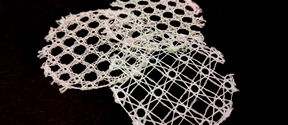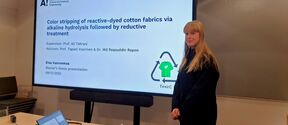An unobtrusive bio-based acoustic coating eliminates echoes and absorbs carbon

A new unobtrusive, spray-on material can dramatically improve the acoustics of a room without changing its appearance. The result is a space that reverberates less without affecting the room’s design or architecture.
The acoustic material, developed by Aalto University researchers in partnership with the company Lumir, is a fibre mass made out of wood cellulose. When sprayed onto a surface, it forms a porous, sound-absorbing layer that follows the underlying shape.
The researchers recently demonstrated the new material in the reading room of an Aalto University building in Helsinki’s Töölö neighbourhood. It used to be the main building of the Aalto University School of Business and is now protected by the Finnish National Board of Antiquities, meaning its appearance must not be altered. With the new acoustic material, the reverberation in the room was easily attenuated while complying with the regulations.
Tapio Lokki, a professor of acoustics at Aalto University, says that the coating significantly improved the acoustics of the room.
‘Two walls of the Töölö reading room were coated. On one wall, the mass was sprayed over glass wool, and on the other, it was sprayed on its own. With these easy steps, the acoustics of the space improved significantly without changing the appearance of the walls. The noise level in the room was significantly reduced, and the end result will sound even better once furniture and people come in.’
Better acoustics and better for the environment
The material can be used to coat a larger area than can be covered with acoustic panels, which are usually only installed on the ceiling. Lumir has already carried out acoustic improvements at other historical sites, such as the Parliament House and the House of Science and Letters.
Producing the new material doesn’t consume much energy. In fact, the final product is carbon negative – more carbon dioxide is captured in the material than is released throughout the entire production process. It is also very durable, Lokki adds with enthusiasm.‘The wall coating in the Töölö reading room will last at least thirty years,’ he says.
Lokki and his team are now studying whether cellulose fibres from hardwood or softwood trees provide better acoustic performance in this material. ‘In our research, we have found that the origin of the fibres also seems to have an impact on acoustics,’ he says. ‘Interdisciplinarity is useful in this work, and we’ve also involved chemists led by Professor Jaana Vapaavuori.’
Close cooperation bears fruit
The collaboration between Aalto University and Lumir began five years ago. Master’s and doctoral students at Aalto have been studying how biomaterials can be used in acoustics.
‘Jose Cucharero is currently doing research for his doctoral dissertation while also working at Lumir,’ says Lokki.
‘The results of his dissertation have already been used in the development of new cellulose-based acoustics solutions, and the research has been quickly applied to product development.’
For Cucharero, working at Lumir while does his doctoral research has been extremely rewarding.
‘I’ve had the opportunity to use research results directly in product development, and my work is not just one piece of research among many,’ he says.
‘Another very positive thing is that I’ve had the chance to go through the research results with various experts in the field. This incorporates diverse views into my research and gives me excellent networking opportunities.’
Tuomas Hänninen, Lumir’s Director of Research and Development and one of Cucharero’s dissertation advisors, also praises the fruitful collaboration.
‘Based on its results alone, we have developed a cellulose-based, carbon negative acoustic panel. We’re also working on an acoustic panel made out of 100% cellulose,’ he says.
‘Achieving the carbon neutrality targets set by decision-makers and companies is simply impossible just by reducing our carbon footprint. We definitely need more innovations that bind atmospheric carbon dioxide into products’, he continues.
Further information:
Professor Tapio Lokki
Aalto University
tel. +358 40 578 2486
tapio.lokki@aalto.fi
Doctoral researcher Jose Cucharero
tel. +358 44 238 4576
jose.cuchareromoya@aalto.fi
Lumir Oy
R&D Director Tuomas Hänninen
Lumir Oy
tel. +358 50 466 6260
tuomas.hanninen@lumir.fi
Read more news

Learning Centre opening hours during Christmas and year-end holidays
Thank you for the past year and have a wonderful holiday season!
Smart textiles are reshaping our understanding of materials – and interspecies communication
The PAST-A-BOT research project, funded by the European Research Council (ERC), is developing soft, intelligent textiles that could one day function as rescue robots, sound-sensing agricultural fabrics, or assistive clothing. At the same time, the project aims to rethink the way we approach materials research.
Master’s student showcases efficient color stripping of cotton fabrics
On December 9, master’s thesis student Elsa Vuorenmaa from the Textile Chemistry Group presented the results of her research on color stripping of reactive-dyed cotton fabrics.






